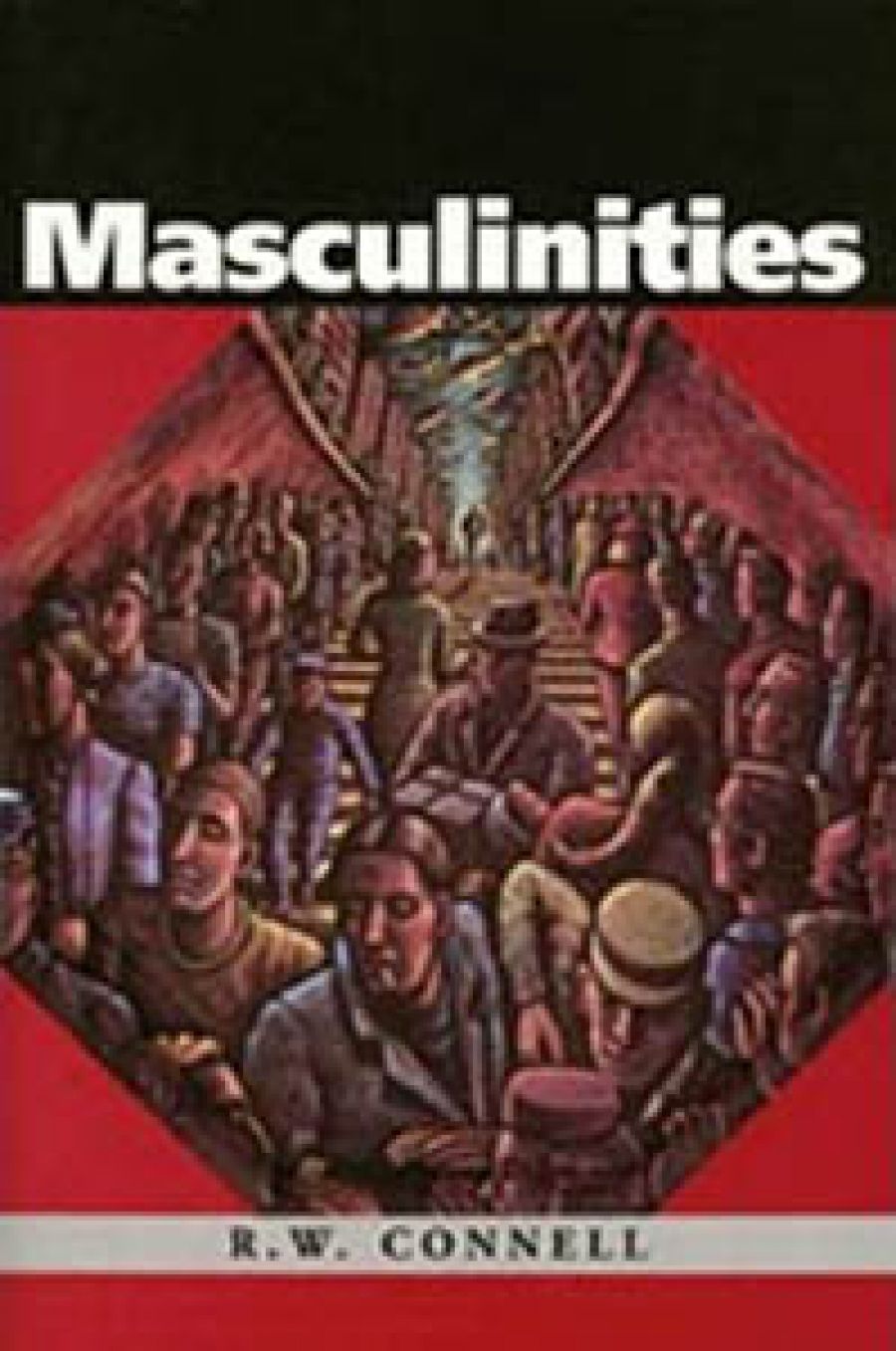
- Free Article: No
- Contents Category: Gender
- Review Article: Yes
- Article Title: Masculine Gender
- Online Only: No
- Custom Highlight Text:
For over twenty years Bob Connell has been a leading figure in the development of an Australian sociology, and his move from Macquarie University to the University of California several years ago was a significant loss to Australian academic life. I wish I could write Australian public life, but our press, which is fond of academics with far less to say than Bob Connell, has largely ignored his work. Nonetheless Connell’s work in class, sexuality, gender, and education is arguably the most distinguished body of social theory written in this country, and deserves far greater acknowledgment.
- Book 1 Title: Masculinities
- Book 1 Biblio: Allen & Unwin, $24.95pb
Masculinities represents Connell’s summary of his work in gender and sexuality over the past two decades, and as such is a work of synthesis rather than one which presents new theories or material. Much of the book has appeared in article form elsewhere, and is here pulled together to make a coherent statement of Connell’s views of the ways in which knowledge and power together form our concepts of gender and sexuality. Connell writes with a commitment to the goals of both women’s and gay liberation; this book, he states, is ‘a fresh attempt to connect knowledge with strategies for change’.
In some ways it is an old-fashioned enterprise; Connell seems disinterested in the proliferation of post-modern theories of discourse and many of the currently fashionable names (Judith Butler, Teresa de Lauretis, Frederick Jameson, Eve Sedgwick) are absent. ‘Bodies’ writes Connell, in what is presumably a barb at much of contemporary intellectual fashion,
do not turn into symbols, signs or positions in discourse. Their materiality (including material capacities to engender, to give birth, to give milk, to menstruate, to open, to penetrate, to ejaculate) is not erased, it continues to matter. The social process of gender includes childbirth and childcare, youth and ageing, the pleasures of sport and sex, labour, injury, death from AIDS.
Yet despite this materialism Connell places a great deal of stress on the importance of psychoanalytic concepts; Freud rather than Foucault is the central point for Connell, which is not to say he is unable to read Freud critically. In some ways Connell (rather like Lyn Segal in her recent book Straight Sex) wants to reclaim the centrality of political agency in discussing sex and gender, and develop ‘a fresh politics of masculinity’.
To do this Connell draws on a range of theoretical frameworks as well as a rich series of individual life stories, based on a series of interviews with men selected from groups for whom ‘the construction or integration of masculinity was under pressure’. These are men drawn from ‘unemployed youth’; ‘soft’ (i.e. counter-cultural and environmentally active) men; gay men; and men in the ‘new middle class’, that is, professional employees.
Theory and life histories come together in an ambitious attempt to construct a picture of ‘the present moment’ in a world marked by rapid technological change and globalisation of both economies and culture. While there is a short discussion of the impact of these on the construction of masculinities in developing countries, it is so cursory as to leave the reader irritated. Connell is right to suggest that we need theories and understandings which go beyond the first world, but his writings remain firmly based in the particularities of contemporary Australia, Britain, and the United States.
And even within the first world he pays relatively little attention to ethnicity, though it seems increasingly the case in this country that sex and gender are differentiated at least as much along lines of ethnicity as of class. (A lack which makes the discussion of strategies far less convincing than it might be, the discussion of class and gender seems strangely unaware of the ethnic component to class divisions.)
For someone unfamiliar with Connell’s work this book would be an exciting introduction, although one demanding a certain degree of attention. While eschewing the high jargon which now characterises so much academic writing, Connell draws on the language of political as well as social analysis (reminding us that like a number of other Australian sociologists he began his career as a political scientist). Thus central to Connell’s work is the assumption of ‘hegemonic masculinity’, a very useful concept which gives us ways of understanding the various structures and relationships which maintain the dominance of heterosexual men in the sex/gender order.
I would expect Masculinities to be widely used for tertiary courses in gender and sexuality, perhaps less widely in literature and philosophy departments than in the social sciences. But it will probably not be read much by the ‘intelligent lay reader’, and that would be a pity. When social theory seeks to enter into a dialogue with the everyday world and suggest strategies for change it should become of concern to others than academics. Connell’s latest book deserves wider reading and discussion than I suspect it will receive.


Comments powered by CComment